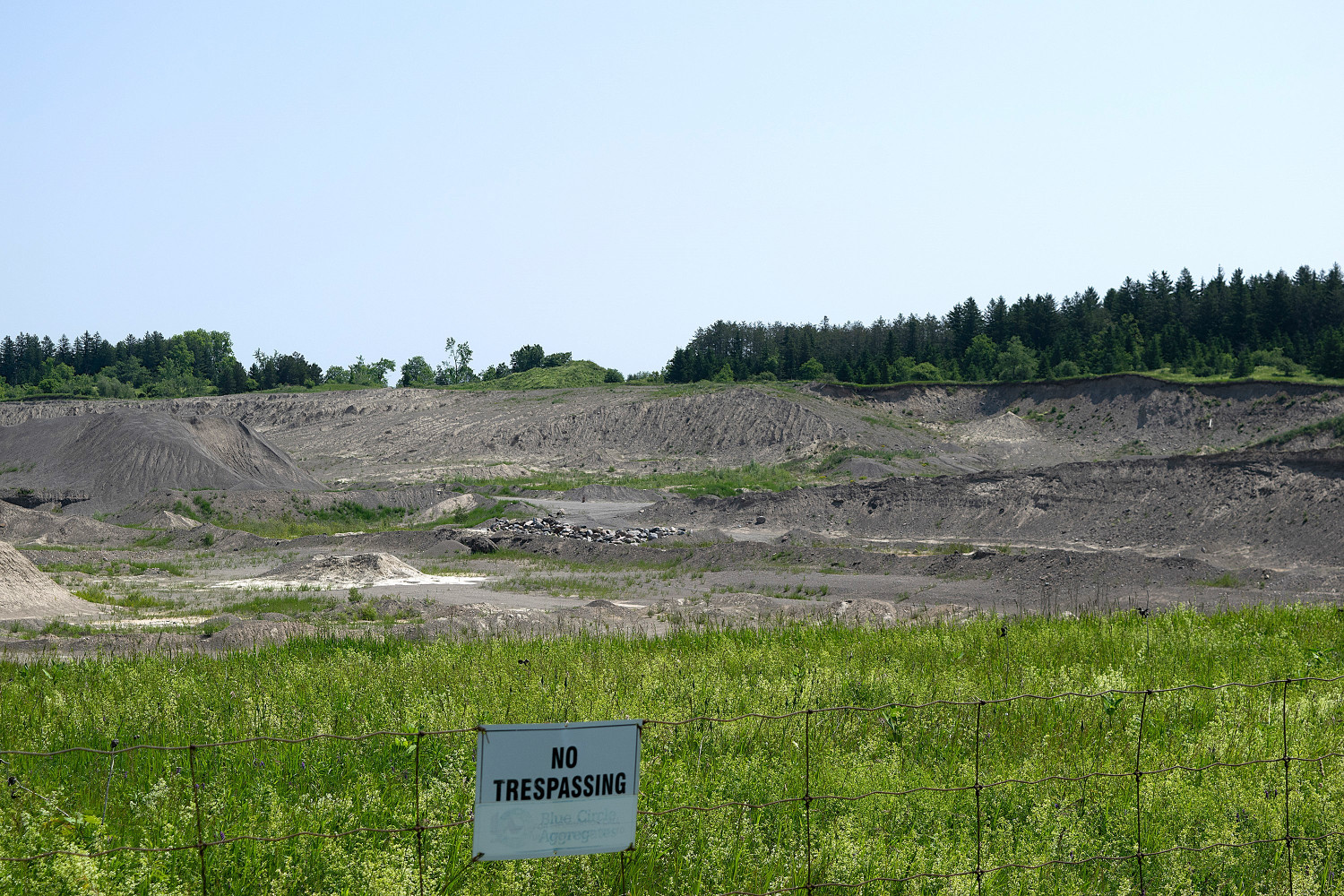
Caledon’s future as a green oasis hangs in the balance: does a new policy to rein in gravel mining go far enough?
Residents of Caledon are finally catching a breath. After a two year process to create stronger policies governing the aggregate industry within the town’s borders, that air they are gulping in may soon be cleaner than it might have been.
The struggle for fresh air, clean water and a healthy environment has been a longstanding issue for residents of Caledon. Community members have found themselves fighting an industry that has altered the landscape for decades, perhaps permanently.
Currently, 1,800 hectares of land within the Town of Caledon are subjected to the cutting, digging and hauling of aggregate extraction, primarily in Ward 1. A satellite view of the area serves as a stark illustration of the toll aggregate operations can take on the environment and community wellbeing.
An example of the extensive toll aggregate operations can take on Caledon’s once pristine landscape.
(Google Maps)
Despite being a major contributor of aggregate in Ontario, used to make concrete to feed the development machine that builds more homes, more roads and more infrastructure to keep up with growth, the Town’s rules meant to ensure the gravel industry respects the local environment have been grossly inadequate. The town was ranked last in the effectiveness of policies related to air and water quality, hydrogeological impacts and First Nations consultation, according to a 2022 study.
This is the main reason why, two years ago, Caledon made efforts to improve these regulations. The new policies came before Town council for approval this week.
Among the recommendations laid out in the proposed Official Plan amendment, which will create an entire new chapter of guidelines around aggregate, the Town stipulates that mineral aggregate operations will be prohibited in evaluated non-provincially significant wetlands and in unevaluated wetlands and their supporting features. The Town is also creating new requirements for blast impact assessments, a flyrock management plan and a vibration management plan—which are directly connected to the proposal from Canada Building Materials (CBM) for an 800-acre mega blasting quarry in Caledon. Any additional policies and safety measures are an improvement to the Town’s previously lax regulatory regime, but the critics of the additions have pointed out they lack crucial elements, including mandated setbacks for aggregate operations from nearby residential properties and the use of noncommittal language that states operators are “encouraged” to undertake certain studies, or “may” create such plans, but are not required to do so.
The CBM proposal has been effectively in limbo since the Town enacted an interim control bylaw (ICBL) at the start of the study process which paused any new aggregate operations in Caledon for one year. The ICBL was extended last year—which was appealed by CBM—and is set to expire on October 18th.
Environmental advocate and lawyer David Donnelly, who works with the Reform Gravel Mining Coalition, and the Forks of the Credit Preservation Group, and has been closely monitoring quarry disputes across Ontario, lauded the Town’s commitment to air quality protection by adhering to the 2021 World Health Organization (WHO) standards for PM2.5 and PM10, two harmful types of particulate matter.
Quarries across Caledon look like cratered moonscapes in the middle of bulldozed greenspaces.
(James Dick Construction)
Particulate matter refers to chemical particles with a diameter of less than 44 microns, roughly half the diameter of a grain of beach sand. Quarries are known to produce high concentrations of PM 10 which is particulate matter with a diameter of 10 microns, and PM 2.5 which has a diameter of 2.5 microns.
“It is a long overdue change,” he emphasized, noting that most of the province is still following the older 2005 WHO standard.
He also described the recent policy changes as a “near perfect reading of the public desire” to protect both the environment and the interests of the community.
(Environmental Protection Agency)
It is clear that more work still needs to be done, including crucial elements necessary to inform these policies. For much of the last year, critics have pointed out that Caledon was not moving fast enough to complete the new rules. With the number of studies left to complete, including significant elements like risk assessments and air quality studies, it would appear the Town is rushing to approve what it can ahead of the expiry of the ICBL. Many voices among the residents insist the town must go further to ensure comprehensive protections are in place, especially as the Town considers the CBM blasting quarry proposal.
"Aggregate resources are essential for road and building construction, but it is also recognized that a quarry blasting below the water table is one of the most noxious, toxic and destructive uses of land, with no reasonable prospect of post-extraction rehabilitation,” a 2022 study by Caledon resident and former FCPG board member, Tony Sevelka, states. “If permitted and established in the wrong geographic location, a blasting quarry operation can result in significant deleterious impacts on the environment and local inhabitants and can disrupt short and long-term land use planning objectives.”
Sevelka told The Pointer the policies in their current form do not go far enough to protect residents and the Town should amend the OPA to include the requirement for a 1,000-metre setback from residential land uses, similar to what was included in the 2019 OPA in the Algonquin Highlands.
“I would also ask the Town of Caledon Council to pass either a zoning by-law or by-law under the Municipal Act imposing a permanent mandatory minimum onsite setback (excavation limit) of 500 metres to protect the health, safety and well-being/welfare of the residents of Caledon, enhancing the recklessly inadequate onsite setback of 30 metres under the Aggregate Resources Act,” Sevelka wrote in an email to all members of council and shared with The Pointer.
Following council's approval of the OPA on Monday evening—it still needs to be approved by the provincial government—Town staff are now tasked with preparing a work program for council approval in early 2025 to address several key projects which include: further studies related to woodlands; preparation of a Caledon Aggregate Standards Manual; the parameters for a Human Health Risk Assessment Review and an air quality study; a review of the 2021 Caledon Aggregate Rehabilitation Master Plan; a report on the Bylaw Enforcement division’s ability to undertake monitoring of mineral aggregate operations; and a strategy for Council advocacy on provincial mineral aggregate policy reform.
During Monday’s meeting, councillors heard from residents involved in the review process, many of whom shared concerns about the misinformation being provided by the aggregate industry, CBM in particular, during the review process. Among these claims was the idea that Caledon needs more aggregate operations to support Ontario’s appetite for stone, sand and gravel.
Updated mapping shows areas in Caledon with potential for aggregate extraction.
(Town of Caledon)
“Not only did CBM’s expert not produce any evidence to support this claim” but an expert from Forks of the Credit Preservation Group (FCPG) used the Ministry of Natural Resources’ online information and licensing tools to calculate that “at minimum 13.4 million tons of gravel per year were generally excavated, but in reality, only about 3 million tons per year are actually taken,” noted Anthony Fairclough, member of the Forks of the Credit Preservation Group, advocating for stricter policies at the Monday town council meeting.
The FCPG's calculations further highlight that there is currently an “unlimited amount of aggregate licensed to be extracted in Caledon.” Fairclough pointed out that existing aggregate operations could meet current demands without the need for new pits or quarries.
Residents have also expressed concerns about the implications of blasting operations, particularly regarding truck traffic that could impact road safety. Mayor Annette Groves highlighted during the council meeting that the town had experienced four accidents on that day alone, including one involving a dump truck.
In light of these concerns, the new report has added a new section that states the Town will work with the province and Peel region to “investigate the building of bypasses around settlement areas where truck volumes or the type of goods being hauled” warrant consideration of this approach.
While Caledon has become accustomed to dealing with aggregate pits, the community is less familiar with quarries, which require blasting and extend below the water table. This raises concerns about air quality due to flyrock, noise pollution, and potential environmental degradation.
Corporations also plan to discharge water from pits and quarries into the Credit River, raising concerns regarding any possible toxicity and the temperature of the water being released. Changes to the watershed’s ecosystem could result in catastrophic problems for the river, which is one of the last remaining habitats for the endangered Brook Trout in southern Ontario.

The Credit River is the last self-sustaining ecosystem for Brook trout in Southern Ontario.
(Steve Noakes/Coalition for the West Credit River)
The Coalition for the West Credit River advocates for these critical habitats, emphasizing that Brook Trout are a highly sensitive coldwater species reliant on stream temperatures no greater than 19 to 20 degrees Celsius for sustained periods.
“Since Caledon has now taken the lead with respect to aggregate policies across Ontario, should other municipalities carefully study what they've done here? …I would make that a very strong recommendation,” Donnelly said.
Concerns also still exist around the new aggregate mapping created as part of this process and now approved as part of the OPA. The creation of the update mapping for the Town of Caledon’s high potential mineral aggregate resource areas (HPMARA) were informed through studies by James Dick Construction Limited (JDCL), one of the largest aggregate operators in the Town of Caledon.
In an email statement to The Pointer last year, the Town of Caledon made contradictory claims about the source of the data used to inform the updated HPMARA blueprint. The purpose of the HPMARA mapping is to determine where mineral aggregate resources lie. A spokesperson told The Pointer the updated mapping was based on Ontario Geological Survey (OGS) data completed in 2009 and 2015, and the Aggregate Resources Inventory Paper—two resources made available by the Government of Ontario. The spokesperson noted it is the Town’s understanding that these resources are “informed by private borehole data”.
However, when asked about the clear conflict of interest created by allowing a private company to provide data that will be used to potentially expand the area for aggregate extraction around the Town, the spokesperson said private industry data was not used in the development of the HPMARA. In the same sentence, the Town neglected to comment on whether there is a pecuniary interest present with JDCL sitting on the working group. The Town also did not comment on why an independent consultant was not brought in to review the data used in the mapping or conduct further studies to complement or verify the data provided by JDCL. These concerns about the mapping have never been addressed.
Email: [email protected]
At a time when vital public information is needed by everyone, The Pointer has taken down our paywall on all stories to ensure every resident of Brampton, Mississauga and Niagara has access to the facts. For those who are able, we encourage you to consider a subscription. This will help us report on important public interest issues the community needs to know about now more than ever. You can register for a 30-day free trial HERE. Thereafter, The Pointer will charge $10 a month and you can cancel any time right on the website. Thank you
Submit a correction about this story


